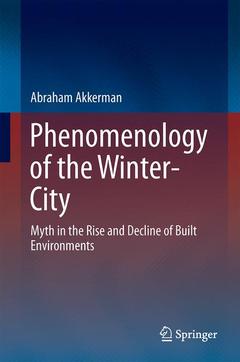Phenomenology of the Winter-City, Softcover reprint of the original 1st ed. 2016 Myth in the Rise and Decline of Built Environments
Langue : Anglais
Auteur : Akkerman Abraham

This book explores how the weather and city-form impact the mind, and how city-form and mind interact. It builds on Merleau-Ponty?s contention that mind, the human body and the environment are intertwined in a singular composite, and on Walter Benjamin?s suggestion that mind and city-form, in mutual interaction, through history, have set the course of civilization. Bringing together the fields of philosophy, urbanism, geography, history, and architecture, the book shows the association of existentialism with prevalence of mood disorder in Northern Europe at the close of Little Ice Age. It explains the implications of city-form and traces the role of the myths and allegories of urban design as well as the history of gender projection onto city-form. It shows how urbanization in Northern Europe provided easier access to shelter, yet resulted in sunlight deprivation, and yielded increasing incidence of depression and other mental disorder among the European middle-class. The book uses the examples of Kierkegaard, Nietzsche, Dostoevsky and Kafka, to show how walking through the streets, squares and other urban voids became the informal remedy to mood disorder, a prominent trait among founders of modern Existentialism. It concludes by describing how the connection of anguish and violence is relevant to winter depression in cities, in North America in particular.
1. Introduction: Intertwining consciousness, human body and the environment.- Part I. Winter and the North in the emergence of civic space.- 2. Human posture and the nightly sky: Cosmos in Diluvial prehistoric myth.- 3. The North, Axis mundi and gender myths: The primordial civic space.- 4. Winter acumen and mood disorder: Apollo, Dionysus and Foucault’s History of Madness.- 5. Hero under the weather: Mood disorder and the emergence of civic space.- 6. Psychocultural aspects of weather and place: The Little Ice Age.- Part II. Body-earth-sky and city-form.- 7. Sky myths and gender projection in early city-form.- 8. The North and paradigms of balance: Harmony and equilibrium as an urban ideal.- 9. Axial Age civilizations as a project of north-hemispheric masculinity: The Antipodean myth.- 10. Philosophical urbanism from Thomas More to Walter Benjamin.- Part III. Phenomenology of the winter-city.- 12. From Cartesian doubt to heroic design: The late LIA and the Myth of the Grand Designer.-13. The late LIA and its urban sequel: Reason, mental illness and the emergence of crowd.- Part IV. Solvitur ambulando.- 14. Aftermaths of the LIA: Loss of place and the North American winter-city .- 15. Epilogue
Born at Prague, Czechoslovakia (now Czech Republic) in 1948; B.A. (1973) in philosophy, Hebrew University of Jerusalem, Israel; M.Sc. (1977) in environmental planning, University of Calgary, Canada; Ph.D. (1982) in urban and regional planning, University of Waterloo, Canada; Principal Planner, City of Edmonton (Canada) Planning Department (1982-1990); Associate Prof. of Geography and Planning, University of Saskatchewan (1990-1995); Professor of Geography and Planning, University of Saskatchewan (1996 – present); Assoc. Member, Department of Philosophy, Univ. of Saskatchewan (2000 – present); Social Sciences and Humanities Research Council of Canada – grant (1992); SSHRC – grant application under review (2014); Fellow: Royal Geographical Society (London, UK); Member: Canadian Institute of Planners; Canadian Population Society.
Is the first to consider weather and city-form jointly in phenomenological research Argues that the sky and city-form are an ongoing force in human contemplation Shows how some urban planning has been driven by a Grand Designer myth
Date de parution : 01-2016
Ouvrage de 230 p.
15.5x23.5 cm
Disponible chez l'éditeur (délai d'approvisionnement : 15 jours).
Prix indicatif 105,49 €
Ajouter au panierDate de parution : 03-2018
Ouvrage de 230 p.
15.5x23.5 cm
Thèmes de Phenomenology of the Winter-City :
© 2024 LAVOISIER S.A.S.


